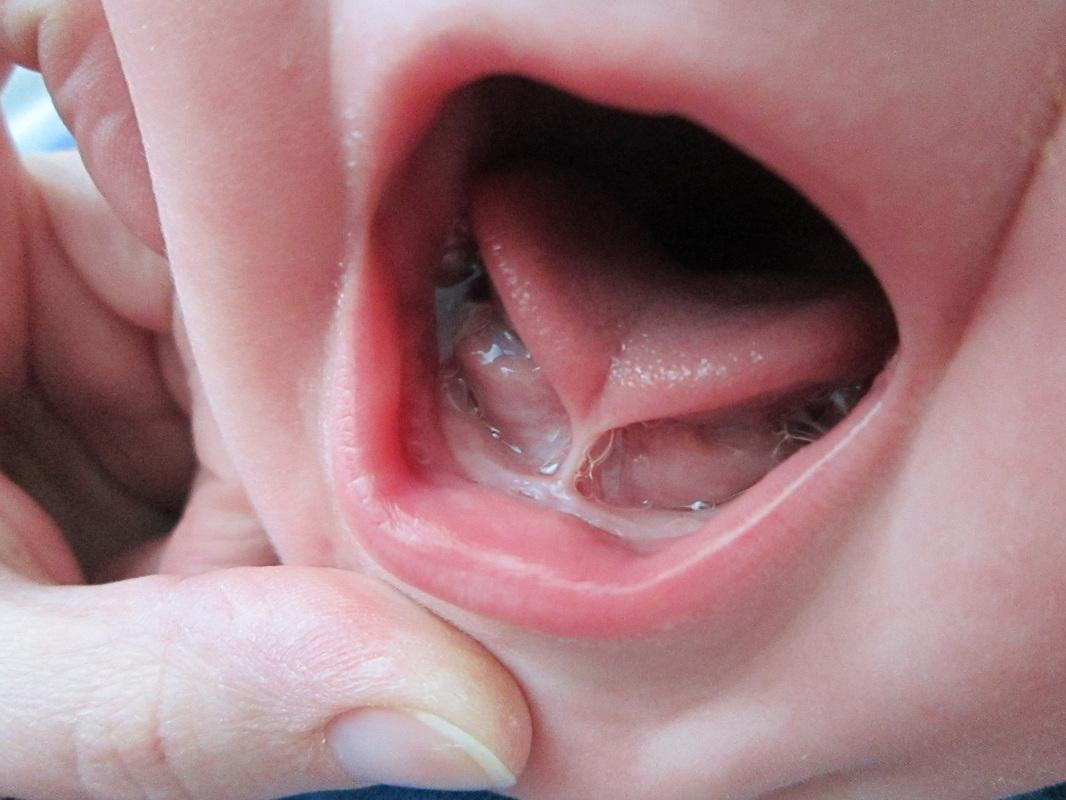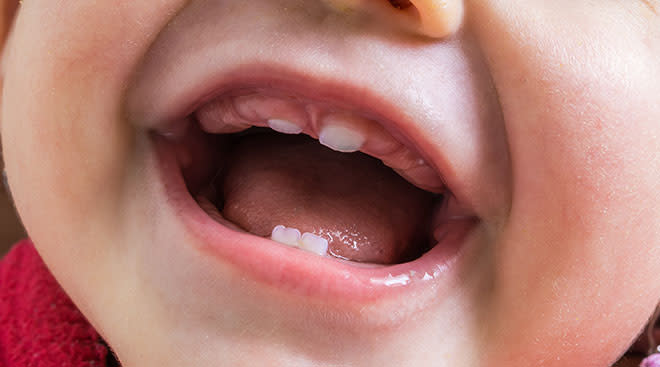We are Myo Munchee Certified!
Chewing not only strengthens your jaw and mouth muscles but also plays a crucial role in maintaining optimal oral health and function. Just as your body needs exercise to stay healthy, your jaw and facial muscles need the right kind of workout too, and that's where the Myo Munchee comes into play. With just 10 minutes of daily chewing exercise, individuals of all ages can enhance the tone and function of their lips, face, and jaw muscles. The Myo Munchee also promotes proper lip closure, correct resting tongue placement, and swallow patterns, all while encouraging healthy nasal breathing habits.

Improper Swallowing
What is improper swallowing?
Orofacial Myofunctional Disorders (OMD) interrupt normal movement patterns and may affect your child’s chewing and swallowing abilities. Individuals with OMD’s oftentimes have early delays with eating and swallowing, adopt picky eating habits due to lack of oral coordination, and develop speech patterns from the associated tongue, lip, and jaw movements that are interrupted.
Are You or Your Child Suffering From:

TMD Therapy
What is TMD/TMJ?
Temporomandibular disorders (TMDs) encompass a group of 30 or more conditions that cause pain and/or dysfunction in the jaw joint and/or in the muscles that control jaw movement. TMJ refers to the temporomandibular joint itself and TMD refers to the disorders associated with the joint.
•Clenching and grinding of teeth
•Jaw and facial pain, tension, and stiffness
•Difficulty opening the mouth wide or yawning
•Pain and tension that radiates into the neck, shoulders, and upper body
•Clicking or grating sounds when opening the mouth, yawning, or chewing
•Hearing difficulties, or Tinnitus (ringing in the ears)
•Locking of the jaw
•Headaches or Dizziness
•Earache
•Toothaches
•Difficulty chewing
Are You or Your Child Having Difficulty:
Our speech therapists use professional techniques to improve speech clarity and teach oral structural placement to clients who struggle to produce or imitate speech sounds using traditional auditory or visual input. We focus on giving you or your child the necessary tools and strategies needed to communicate their needs, ideas, and thoughts to the world.
Together we will determine individualized goals and a plan of action according to you or your child’s needs. Our speech-language pathologists will work closely with you, the parents, and additional caregivers throughout therapy, ensuring everyone is working together towards the primary goal.

LET US SUPPORT YOU
Our speech therapists use professional techniques to improve speech clarity and teach oral structural placement to clients who struggle to produce or imitate speech sounds using traditional auditory or visual input. We focus on giving you or your child the necessary tools and strategies needed to communicate their needs, ideas, and thoughts to the world.
Together we will determine individualized goals and a plan of action according to you or your child’s needs. Our speech-language pathologists will work closely with you, the parents, and additional caregivers throughout therapy, ensuring everyone is working together towards the primary goal.

Lip Tie and Tongue Tie

Orofacial Myofunctional Therapy
What is a lip tie, or tongue tie?
A tongue tie is a condition where the tongue is tethered to the floor of the mouth by a membrane (frenulum) which restricts the mobility of the tongue.


Lip ties are restricted tissue under the midline of the upper lip.
After a tongue tie release and occasionally after a lip tie release, myotherapy is recommended for both adults and children. Many children and adults can benefit from myofunctional therapy to learn the correct resting tongue position, and how to chew, swallow and breathe appropriately.
Our speech therapists use professional techniques to improve speech clarity and teach oral structural placement to clients who struggle to produce or imitate speech sounds using traditional auditory or visual input. We focus on giving you or your child the necessary tools and strategies needed to communicate their needs, ideas, and thoughts to the world.
Together we will determine individualized goals and a plan of action according to you or your child’s needs. Our speech-language pathologists will work closely with you, the parents, and additional caregivers throughout therapy, ensuring everyone is working together towards the primary goal.

Tongue Thrust Therapy
What is Tongue Thrusting?
Tongue thrusting, simply defined, is the habit of placing the tongue in the wrong position during swallowing, either too far forward or to the sides.
Tongue thrust appears when the tongue presses forward too far in the mouth, resulting in an abnormal orthodontic condition called an “open bite.”

LET US SUPPORT YOU

LET US SUPPORT YOU
•An “open bite” or lisp
•Tongue visibility between the teeth
•Inability or difficulty closing the mouth
•Speech impediments or difficulty while speaking
•Messy or sloppy eating
•Breathing through the mouth
Are You or Your Child Suffering From:

LET US SUPPORT YOU
Our speech therapists use professional techniques to improve speech clarity and teach oral structural placement to clients who struggle to produce or imitate speech sounds using traditional auditory or visual input. We focus on giving you or your child the necessary tools and strategies needed to communicate their needs, ideas, and thoughts to the world.
Together we will determine individualized goals and a plan of action according to you or your child’s needs. Our speech-language pathologists will work closely with you, the parents, and additional caregivers throughout therapy, ensuring everyone is working together towards the primary goal.
•Coughing or choking when eating or drinking
•Bringing food back up, sometimes through the nose
•A sensation that food is stuck in your throat or chest
•Persistent drooling of saliva
•Weight loss
•Incorrect tongue and lip resting posture consisting of an open mouth, low, forward resting position of the tongue against and between the teeth
•Oral habits such as thumb, finger, or pacifier sucking habits, and other oral habits including fingernail biting, lip biting, lip licking, and lip, and tongue sucking habits.
Infants
•Poor latch, unable to sustain a latch
•Poor weight gain
•Colic & excessive gassiness
•The baby often loses suction whilst feeding and sucks in air
•Difficulty with adequate milk intake
•A clicking sound, from baby’s TMJ while feeding
•Extended nursing episodes
•Unable to develop a deep enough latch
•Early weaning from the breast
•The tongue cannot be moved sideways
•The tongue cannot protrude beyond the baby’s lips
Restricted mobility interferes with bottle feeding
When extended, the tongue tip may look flat or square instead of pointed
Children
•Inability to chew age-appropriate solid foods
•Gagging, choking, or vomiting foods
•Difficulties related to dental hygiene
Persistence of dribbling
•Delayed development of speech, or deterioration in speech
•Behavior problems
•Loss of self-confidence because they feel and sound ‘different’
•Airway issues
•Mouth breathing
•Snoring
•ADD or ADHD like symptoms
Adults
•The inability to open the mouth widely affects speech and eating habits.
•Always having to watch their speech
•Inability to speak clearly when talking fast/loud/soft
•Clicky and/or painful jaws
•Protrusion of the lower jaws
•Posture issues, abnormal head tilt, and neck & shoulder pain
•Poor dental health, frequently inflamed gums, and increased need for fillings and extractions
•Migraines
•Mouth breathing
•Snoring





